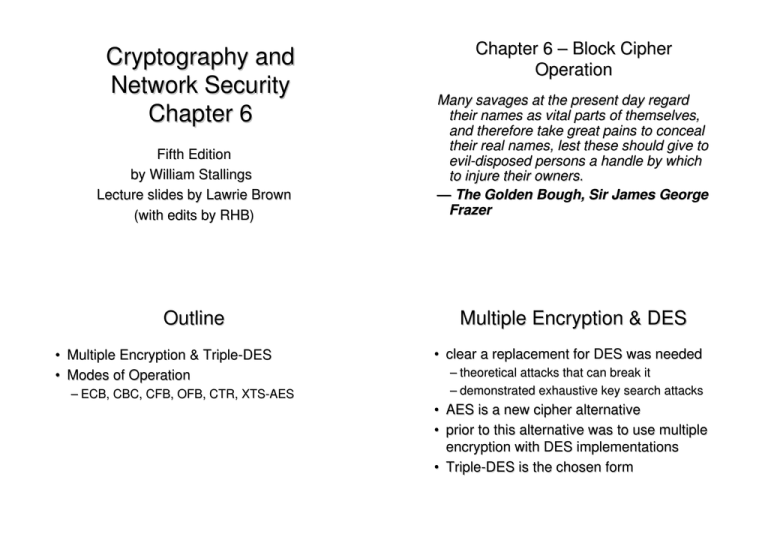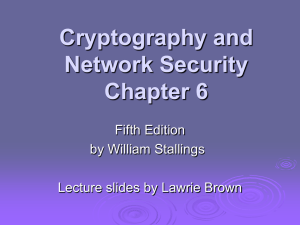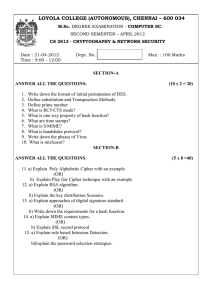Cryptography and Network Security Chapter 6
advertisement

Cryptography and Network Security Chapter 6 Chapter 6 – Block Cipher Operation Fifth Edition by William Stallings Lecture slides by Lawrie Brown (with edits by RHB) Many savages at the present day regard their names as vital parts of themselves, and therefore take great pains to conceal their real names, lest these should give to evil-disposed persons a handle by which to injure their owners. — The Golden Bough, Sir James George Frazer Outline Multiple Encryption & DES • Multiple Encryption & Triple-DES • Modes of Operation – ECB, CBC, CFB, OFB, CTR, XTS-AES • clear a replacement for DES was needed – theoretical attacks that can break it – demonstrated exhaustive key search attacks • AES is a new cipher alternative • prior to this alternative was to use multiple encryption with DES implementations • Triple-DES is the chosen form Double-DES? • could use 2 DES encrypts on each block – C = EK2(EK1(P)) • issue of reduction to single stage • and have “meet-in-the-middle” attack – works whenever use a cipher twice – since X = EK1(P) = DK2(C) – attack by encrypting P with all keys and store – then decrypt C with keys and match X value – can show takes O(256) steps Triple-DES with Three-Keys • although are no practical attacks on twokey Triple-DES, have some doubts • can use Triple-DES with Three-Keys to avoid even these – C = EK3(DK2(EK1(P))) • has been adopted by some Internet applications, eg PGP, S/MIME Triple-DES with Two-Keys • hence must use 3 encryptions – would seem to need 3 distinct keys • but can use 2 keys with E-D-E sequence – C = EK1(DK2(EK1(P))) – nb encrypt & decrypt equivalent in security – if K1 = K2 then can work with single DES • standardized in ANSI X9.17 & ISO8732 • no current known practical attacks – several proposed impractical attacks might become basis of future attacks Modes of Operation • block ciphers encrypt fixed size blocks – eg. DES encrypts 64-bit blocks with 56-bit key • need some way to en/decrypt arbitrary amounts of data in practise • NIST SP 800-38A defines 5 modes • have block and stream modes • to cover a wide variety of applications • can be used with any block cipher Electronic Codebook Book (ECB) • message is broken into independent blocks which are encrypted • each block is a value which is substituted, like a codebook, hence name • each block is encoded independently of the other blocks Electronic Codebook Book (ECB) Ci = EK(Pi) • uses: secure transmission of single values Advantages and Limitations of ECB • message repetitions may show in ciphertext – if aligned with message block – particularly with data such graphics – or with messages that change very little, which become a code-book analysis problem • weakness is due to the encrypted message blocks being independent • main use is sending a few blocks of data Cipher Block Chaining (CBC) • message is broken into blocks • linked together in encryption operation • each previous cipher blocks is chained with current plaintext block, hence name • use Initial Vector (IV) to start process Ci = EK(Pi XOR Ci-1) C-1 = IV • uses: bulk data encryption, authentication Message Padding Cipher Block Chaining (CBC) • at end of message must handle a possible last short block – which is not as large as blocksize of cipher – pad either with known non-data value (eg nulls) – or pad last block along with count of pad size • eg. [ b1 b2 b3 0 0 0 0 5] • means have 3 data bytes, then 5 bytes pad+count – this may require an extra entire block over those in message • there are other, more esoteric modes, which avoid the need for an extra block Advantages and Limitations of CBC • a ciphertext block depends on all blocks before it • any change to a block affects all following ciphertext blocks • need Initialization Vector (IV) – which must be known to sender & receiver – if sent in clear, attacker can change bits of first block, and change IV to compensate – hence IV must either be a fixed value (as in EFTPOS) – or must be sent encrypted in ECB mode before rest of message Stream Modes of Operation • block modes encrypt entire block • may need to operate on smaller units – real time data • convert block cipher into stream cipher – cipher feedback (CFB) mode – output feedback (OFB) mode – counter (CTR) mode • use block cipher as some form of pseudorandom number generator Cipher FeedBack (CFB) • • • • message is treated as a stream of bits added to the output of the block cipher result is fed back for next stage (hence name) standard allows any number of bit (1,8, 64 or 128 etc) to be feed back – denoted CFBCFB-1, CFBCFB-8, CFBCFB-64, CFBCFB-128 etc • most efficient to use all bits in block (64 or 128) Ci = Pi XOR EK(Ci-1) C-1 = IV s-bit Cipher FeedBack (CFB-s) (with suitable shifts) • uses: stream data encryption, authentication Output FeedBack (OFB) Advantages and Limitations of CFB • • • appropriate when data arrives in bits/bytes most common stream mode limitation is need to stall while do block encryption after every n-bits • block cipher is used in encryption mode at both ends to yield ps-random bitstream • errors propagate for several blocks after the error (but not indefinitely) • • • • • message is treated as a stream of bits output of cipher is added to message output is then fed back (hence name) feedback is independent of message can be computed in advance Oi = EK(Oi-1) Ci = Pi XOR Oi O-1 = IV (Nonce) • uses: stream encryption on noisy channels Advantages and Limitations of OFB • needs an IV which is unique for each use – if ever reuse attacker can recover outputs • bit errors do not propagate • more vulnerable to message stream modification • sender & receiver must remain in sync • only use with full block feedback Output FeedBack (OFB) – subsequent research has shown that only full block feedback (ie CFBCFB-64 or CFBCFB-128) should ever be used Counter (CTR) • a “new” mode, though proposed early on • similar to OFB but encrypts counter value rather than any feedback value • must have a different key & counter value for every plaintext block (never reused) Oi = EK(i) Ci = Pi XOR Oi • uses: high-speed network encryptions Counter (CTR) Advantages and Limitations of CTR • efficiency – can do parallel encryptions in h/w or s/w – can preprocess in advance of need – good for bursty high speed links • random access to encrypted data blocks • provable security (good as other modes) • but must ensure never reuse key/counter values, otherwise could break (cf OFB) Feedback Characteristics XTS-AES Mode • new mode, for block oriented storage use – in IEEE Std 1619-2007 • concept of tweakable block cipher • different requirements to transmitted data • uses AES twice for each block Tj = EK2(i) × αj (× and exp. in GF(2128)) Cj = EK1(Pj XOR Tj) XOR Tj where i is tweak and j is sector no • each sector may have multiple blocks XTS-AES Mode per block Advantages and Limitations of XTS-AES • efficiency XTS-AES Mode Overview – can do parallel encryptions in h/w or s/w – random access to encrypted data blocks • has both nonce & counter • addresses security concerned related to stored data






